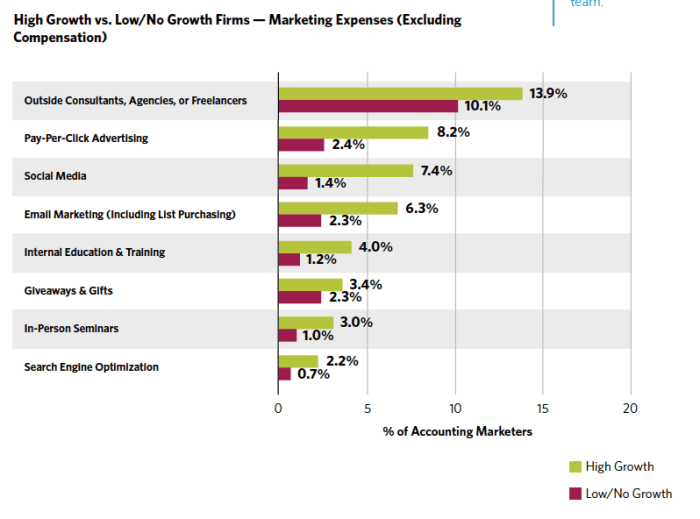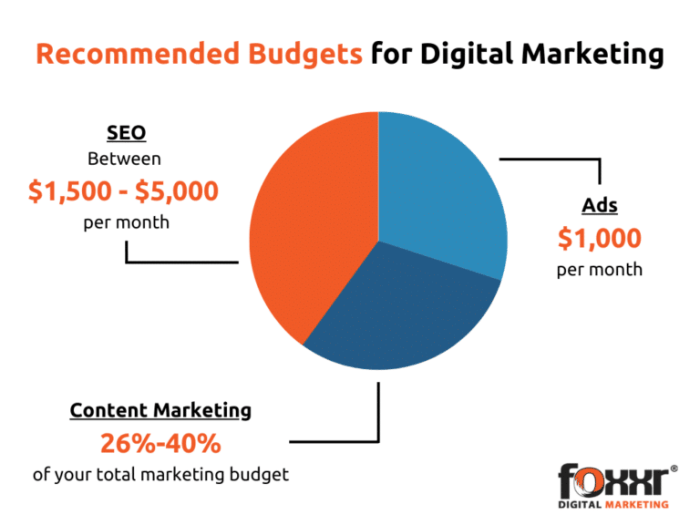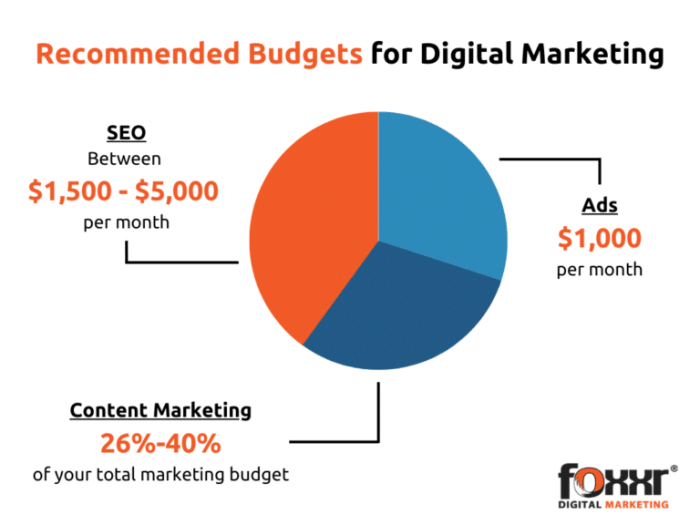Building a better CPA marketing budget sets the stage for maximizing your return on investment. This guide delves into the crucial steps for defining your goals, analyzing your current budget, identifying optimization opportunities, and implementing a robust strategy. We’ll explore various budget models, marketing channel strategies, and essential tools to help you craft a CPA marketing budget that drives significant results.
From meticulously defining conversion goals and KPIs to optimizing budget allocation across different channels, this comprehensive guide offers actionable insights. We’ll examine strategies for improving ROAS, identifying underperforming campaigns, and leveraging data analysis to fine-tune your approach. Finally, we’ll provide a practical framework for implementation, monitoring, and continuous improvement.
Defining CPA Marketing Goals
CPA marketing, or Cost Per Acquisition marketing, focuses on driving profitable customer actions. This involves setting clear objectives and tracking performance meticulously to optimize campaigns for maximum return on investment. Defining specific, measurable, achievable, relevant, and time-bound (SMART) goals is crucial for success.CPA marketing success hinges on a well-defined target audience and understanding their needs. This involves identifying the ideal customer profile (ICP) and aligning marketing efforts with their motivations.
This strategy ensures the campaigns are not just generating leads but also fostering conversions that directly translate into tangible business growth.
CPA Marketing Objectives
CPA marketing campaigns are driven by specific objectives, each aimed at a different stage of the customer journey. These objectives translate into tangible results for businesses. Identifying the primary objective is paramount for a successful marketing strategy.
- Lead Generation: This involves attracting potential customers and collecting their contact information. Lead generation is a critical first step in the sales funnel, providing a pool of potential clients for future engagement.
- Sales Conversions: This objective focuses on transforming leads into paying customers. Successful sales conversions directly impact revenue and profitability.
- App Downloads: For mobile-centric businesses, app downloads are a key objective. This metric tracks the number of users installing and engaging with a specific mobile application.
- Website Traffic: Increasing website traffic is often a preliminary objective, especially when building brand awareness. It serves as a precursor to other goals, such as lead generation and conversions.
- Brand Awareness: This objective focuses on raising recognition and visibility for a company or product. This can be measured through social media engagement, mentions, and other forms of brand exposure.
Conversion Goals
Conversion goals are the specific actions you want users to take on your website or app. These goals are directly tied to your overall marketing objectives.
- Lead Generation: Conversion goals might include completing a form, subscribing to a newsletter, or requesting a demo. This data provides valuable information about potential customers.
- Sales: Conversion goals might include making a purchase, signing up for a subscription, or completing an order. This is the ultimate goal in many CPA marketing campaigns, focusing on tangible revenue generation.
- App Downloads: Conversion goals for app campaigns focus on getting users to download and install the app. This metric directly reflects the app’s reach and potential user base.
SMART Goals for CPA Marketing Campaigns
SMART goals provide a structured framework for setting realistic and achievable targets. This ensures that the goals are well-defined and lead to quantifiable results.
- Specific: Clearly define the desired outcome. Instead of “increase sales,” aim for “increase sales by 15% in Q3 2024.”
- Measurable: Establish metrics to track progress toward the goal. For instance, track the number of leads generated per day.
- Achievable: Set goals that are realistic given resources and market conditions. Avoid overly ambitious targets.
- Relevant: Align the goals with the overall business strategy and target audience. Ensure that the goals are pertinent to the business’s objectives.
- Time-Bound: Establish a timeframe for achieving the goal. Set deadlines for each stage of the campaign.
Key Performance Indicators (KPIs) for CPA Marketing Success
KPIs provide crucial insights into the effectiveness of your CPA marketing campaigns. Tracking these metrics is essential for identifying areas for improvement and optimizing your strategies.
| KPI | Description | Example |
|---|---|---|
| Cost per Acquisition (CPA) | The cost incurred to acquire a single customer. | $50 |
| Conversion Rate | Percentage of visitors who complete a desired action. | 10% |
| Click-Through Rate (CTR) | Percentage of impressions that result in clicks. | 2% |
| Return on Ad Spend (ROAS) | Profit generated per dollar spent on advertising. | 3:1 |
| Customer Lifetime Value (CLTV) | The total revenue a customer is expected to generate throughout their relationship with the business. | $500 |
Analyzing Current Budget Allocation
Understanding your current CPA marketing budget is crucial for optimizing its effectiveness. A deep dive into your spending habits reveals areas where you might be overspending on underperforming channels or underinvesting in high-potential ones. This analysis is a critical step toward creating a more efficient and profitable marketing strategy.A well-structured CPA marketing budget allows you to track and adjust spending based on performance.
It enables you to allocate resources effectively to maximize returns on investment (ROI). This process isn’t just about numbers; it’s about understanding which strategies are working and which need improvement.
Evaluating Current Budget Structure
Your current budget structure should be evaluated against key performance indicators (KPIs) to assess its effectiveness. This evaluation involves examining the allocation across different marketing channels, considering campaign performance, and identifying areas where the budget is being underutilized or overspent. A thorough analysis will provide actionable insights to optimize your budget for better results.
Identifying Overspending and Underutilization
Pinpointing areas of overspending and underutilization is a crucial step in optimizing your budget. By carefully reviewing historical data, you can identify campaigns or channels that aren’t delivering a satisfactory return on investment (ROI). Conversely, you can also pinpoint campaigns that are performing exceptionally well, suggesting areas where you could potentially increase spending. Regular review and analysis of campaign data are essential for proactive adjustments.
Budget Allocation Models
Different models exist for allocating your CPA marketing budget. A common approach is cost-per-click (CPC), where you pay for each click on an advertisement. Cost-per-acquisition (CPA) focuses on paying only when a specific action, such as a sale or lead generation, is achieved. Other models include cost-per-thousand impressions (CPM) and cost-per-engagement (CPE). Choosing the right model depends on your specific marketing objectives and the nature of your campaigns.
Figuring out a better CPA marketing budget can be tricky, but recent developments like Microsoft officially launching Copilot Search in Bing ( microsoft officially launches copilot search in bing ) might offer some unexpected insights. This new search technology could potentially change how we approach keyword targeting and ad copy, ultimately influencing the cost-per-action in our campaigns. By understanding how this shift impacts online search behavior, we can better refine our CPA strategies and get a clearer picture of optimal budget allocation.
Cost-per-click (CPC) models are suitable for driving website traffic, while cost-per-acquisition (CPA) models are better for focusing on conversions.
Spreadsheet Template for Budget Performance Analysis
A well-structured spreadsheet is essential for tracking and analyzing budget performance. This template should include columns for campaign name, channel, date range, budget allocated, cost per acquisition (CPA), conversion rate, and return on ad spend (ROAS).
| Campaign Name | Channel | Date Range | Budget Allocated | CPA | Conversion Rate | ROAS |
|---|---|---|---|---|---|---|
| Social Media Campaign | 2024-01-01 to 2024-01-31 | $1000 | $50 | 5% | 2.0 | |
| Search Engine Campaign | Google Ads | 2024-01-01 to 2024-01-31 | $1500 | $75 | 3% | 1.5 |
This structured template will enable you to effectively track and analyze the performance of your campaigns, allowing for data-driven adjustments to your budget allocation.
Developing a New Budget Strategy
Crafting a robust CPA marketing budget isn’t just about throwing money at ads. It’s a strategic exercise requiring careful consideration of your goals, current performance, and future projections. This section delves into building a new budget framework, emphasizing ROI-driven allocation and actionable steps for implementation.A well-structured CPA marketing budget is crucial for optimizing campaign performance and achieving desired results.
By meticulously analyzing predicted ROI for each marketing channel, businesses can allocate resources effectively. This approach ensures that budget dollars are invested in channels most likely to deliver a substantial return, leading to greater efficiency and profitability.
Framework for Constructing a More Effective CPA Budget
A solid framework for a CPA marketing budget involves several key components. It begins with clearly defined goals and metrics, followed by a comprehensive analysis of your current performance and competitor strategies. This understanding provides the foundation for forecasting future performance and making informed decisions regarding resource allocation. Predictive modeling tools can further refine these projections, enhancing the accuracy of budget estimations.
Strategies for Allocating Budget Based on Predicted ROI
Optimizing budget allocation hinges on accurately predicting ROI for each marketing channel. This requires a deep understanding of historical campaign performance, current market trends, and competitor activities. Consider factors such as conversion rates, customer lifetime value, and average order value when calculating projected ROI. For example, if a particular channel consistently demonstrates a high conversion rate and low cost-per-acquisition (CPA), it warrants a larger budget allocation in the upcoming period.
Likewise, channels with low conversion rates and high CPAs may need a reduced budget allocation.
Comparing Marketing Channels and Associated Costs
This table provides a comparative overview of various marketing channels, including their associated costs and potential ROI. It’s crucial to understand the dynamics of each channel and their unique strengths and weaknesses.
| Marketing Channel | Estimated CPA | Potential ROI | Strengths | Weaknesses |
|---|---|---|---|---|
| Google Ads | $20-$50 | High | Wide reach, targeted advertising | Requires ongoing optimization, competition |
| Social Media Ads (Facebook, Instagram) | $5-$25 | Moderate to High | Highly targetable, diverse audience reach | Algorithm changes can impact visibility |
| Influencer Marketing | $50-$500+ | High (with proper selection) | High credibility, targeted audience | Difficult to measure ROI accurately, influencer fraud |
| Email Marketing | $1-$5 | Moderate | Cost-effective, direct communication | Requires a strong email list, potential for spam |
| Content Marketing | Variable (can be very low) | High (long-term) | Builds brand awareness, long-term value | Takes time to generate results, requires consistent effort |
Note: CPAs are estimates and will vary based on industry, campaign specifics, and other factors.
Step-by-Step Guide for Implementing a New Budget Strategy
Implementing a new budget strategy involves several key steps.
- Review and Refine Goals: Ensure that your goals remain aligned with your overall business objectives and are measurable. Regularly monitor your progress towards these goals.
- Analyze Historical Data: Thoroughly analyze historical campaign data to identify patterns and trends. Identify high-performing channels and areas for improvement.
- Project Future Performance: Utilize predictive modeling to project future performance based on current trends and market conditions. This helps you anticipate potential challenges and optimize resource allocation.
- Allocate Budget Based on ROI: Allocate budget to channels with the highest predicted ROI. Adjust allocations based on ongoing performance monitoring and analysis.
- Establish Monitoring and Reporting: Implement a robust system for tracking campaign performance and measuring ROI. Regular reporting and analysis are crucial for ongoing optimization.
Implementing and Monitoring the Budget

Putting your CPA marketing budget into action and consistently tracking its performance is crucial for achieving your goals. A well-defined strategy is only the first step. The true test lies in its execution and ongoing evaluation. This section focuses on the practical steps for implementing your new budget strategy and establishing a robust monitoring process to ensure you’re on track and making necessary adjustments.Successfully implementing a new budget requires a structured approach.
This includes clearly assigning responsibilities, setting timelines, and establishing clear communication channels. This will not only keep the budget on track but also foster accountability and transparency within your team.
Implementation Process
Implementing a new CPA marketing budget requires a structured approach. This involves a phased rollout that allows for adjustments and optimization along the way. First, thoroughly review the new budget with all relevant stakeholders to ensure everyone understands the changes and their roles. Second, meticulously allocate funds across different campaigns and channels, ensuring alignment with the defined goals.
Finally, carefully monitor performance against established metrics and be prepared to make necessary adjustments based on data. Clear communication channels and established reporting mechanisms are vital for smooth implementation and timely adjustments.
Monitoring Campaign Performance
Monitoring campaign performance against the budget is essential for identifying areas of strength and weakness. A crucial part of this is establishing key performance indicators (KPIs) that align with your budget goals. This could include cost per acquisition (CPA), conversion rate, click-through rate (CTR), and return on ad spend (ROAS). Tracking these metrics regularly allows you to assess campaign effectiveness and identify any deviations from the projected budget.
Continuous Analysis and Adjustments
Continuous analysis and adjustments are paramount to optimize campaign performance and ensure budget efficiency. This involves regularly reviewing campaign data, identifying areas for improvement, and making proactive changes to your strategy. This could involve shifting budget allocations to higher-performing channels, modifying ad copy or targeting, or exploring new strategies. Consistent analysis enables you to remain adaptable and responsive to changes in the market and your campaign performance.
This iterative process is essential for achieving your CPA goals.
Tracking Metrics and Budget Adjustments
A comprehensive tracking plan is vital for monitoring campaign performance and making informed budget adjustments. This plan should detail the metrics you’ll track, the frequency of monitoring, and the thresholds for triggering adjustments.
- Metrics to Track: Cost per acquisition (CPA), conversion rate, click-through rate (CTR), return on ad spend (ROAS), impressions, clicks, and leads. These metrics provide a comprehensive view of campaign performance, allowing for a data-driven approach to budget adjustments.
- Frequency of Monitoring: Establish a regular schedule for reviewing campaign performance data, ideally daily or weekly, depending on the campaign’s scale and the volatility of the market. This allows for timely intervention and prevents issues from escalating.
- Thresholds for Adjustments: Define specific performance thresholds that will trigger adjustments to the budget. For example, if the CPA for a particular campaign exceeds a certain limit or if the conversion rate drops below a specified level, this triggers a review of the campaign and potential budget adjustments. Examples could include lowering the budget for underperforming campaigns and increasing it for campaigns exceeding expectations.
| Metric | Target | Threshold for Adjustment |
|---|---|---|
| CPA | $50 | $75 |
| Conversion Rate | 5% | 3% |
| ROAS | 300% | 200% |
Illustrative Budget Breakdown

A well-defined CPA marketing budget is crucial for success. It allows for strategic allocation of resources across various channels, optimizing campaign performance and maximizing return on investment (ROI). This section provides a detailed breakdown of a sample budget, highlighting key considerations for allocating funds effectively.
Sample CPA Marketing Budget Breakdown
This example budget assumes a hypothetical e-commerce business targeting a specific demographic. The budget is designed to be flexible and adaptable to changing market conditions and campaign performance. Key elements include awareness, consideration, and conversion stages of the sales funnel, each receiving proportionate funding.
Budget Allocation Across Marketing Channels, Building a better cpa marketing budget
Effective budget allocation requires careful consideration of the strengths and weaknesses of each marketing channel. Different platforms attract different customer segments, and their performance varies significantly. For example, a platform that excels at generating leads may underperform in driving conversions. A balanced approach across channels is essential to capture the widest audience possible and maintain consistent engagement.
| Marketing Channel | Percentage Allocation | Justification |
|---|---|---|
| Google Ads (Search & Display) | 35% | High potential for targeted reach and measurable results. Includes both search-based campaigns for direct product searches and display campaigns for brand awareness. |
| Social Media Marketing (Facebook, Instagram, TikTok) | 30% | Effective for building brand awareness and engaging with a younger demographic. Targeting options enable precise audience segmentation. |
| Email Marketing | 15% | Nurturing leads, promoting products, and driving conversions through targeted email campaigns. Essential for customer retention and loyalty. |
| Content Marketing (Blog, Articles, Videos) | 10% | Long-term strategy focused on providing valuable content to attract organic traffic. Builds credibility and trust over time. |
| Influencer Marketing | 10% | Leveraging trusted voices to reach a wider audience and increase brand visibility. Can be highly effective, especially when aligning with specific demographics. |
Budget Allocation by Sales Funnel Stage
Understanding the customer journey is vital for allocating budget effectively. The budget should be distributed proportionally to the needs of each stage of the sales funnel.
- Awareness: Allocate a portion of the budget to channels that focus on creating brand awareness, driving initial interest, and introducing potential customers to your products or services. Examples include social media campaigns and content marketing initiatives. These initiatives aim to generate leads. A smaller portion of the budget is usually sufficient, as the focus is on generating leads.
- Consideration: Allocate a larger portion of the budget to channels that focus on educating potential customers about your offerings and building trust. Examples include content marketing, email marketing, and influencer collaborations. The goal is to nurture leads, address their needs, and demonstrate expertise. Conversion rates should be higher in this stage compared to awareness.
- Conversion: Allocate the largest portion of the budget to channels that focus on driving conversions. Examples include targeted advertising campaigns (like Google Ads) and optimizing landing pages. The focus is on converting qualified leads into paying customers. This stage involves a substantial budget to drive the conversions.
Budgeting for Different Marketing Channels
Crafting a robust CPA marketing budget necessitates a nuanced approach to allocating resources across various channels. A one-size-fits-all strategy rarely works; instead, a deep dive into the unique characteristics of each channel is crucial for maximizing ROI. This section delves into tailored budgeting strategies for different marketing channels, highlighting their respective costs and effectiveness.Understanding the specific strengths and weaknesses of each channel is paramount.
Some channels excel at driving brand awareness, while others are more focused on direct conversions. By strategically allocating resources based on these distinctions, marketers can achieve a more balanced and effective campaign.
Search Engine Marketing (SEM) Budgeting
Search engine marketing (SEM) campaigns, typically run through platforms like Google Ads, are performance-driven. Budgeting for SEM demands a proactive approach that combines research, campaign optimization, and continuous monitoring. Successful SEM campaigns necessitate a well-defined target audience, carefully selected s, and precise ad copy. Allocate a portion of your budget to test different ad variations and landing pages, and track their performance to optimize conversions.
Social Media Advertising Budgeting
Social media advertising provides a vast reach and targeting options. However, the effectiveness of social media campaigns is often contingent on platform-specific best practices. Each platform, such as Facebook, Instagram, or TikTok, has its own audience demographics and ad formats. Understanding these nuances is crucial for maximizing ROI. Consider the cost-per-click (CPC) or cost-per-thousand impressions (CPM) on different platforms and adapt your budget accordingly.
A key aspect of social media budgeting involves identifying high-performing content formats and ad creatives to maximize engagement and conversions.
Content Marketing Budgeting
Content marketing strategies focus on creating valuable and engaging content that attracts and retains target audiences. Content creation, optimization, and promotion strategies are integral components of a comprehensive content marketing budget. The cost associated with content marketing can vary significantly based on the complexity of the content, the expertise needed for creation, and the chosen promotion channels.
Allocate funds for various content types, including blog posts, articles, videos, and infographics, to cater to diverse audience preferences.
Email Marketing Budgeting
Email marketing, a direct communication channel, requires a budget focused on list growth, email design, and campaign management. A successful email marketing budget must consider the cost of acquiring email addresses, crafting engaging email content, and automating email sequences. Segmenting your email list allows for more targeted messaging and potentially higher conversion rates. Evaluate the cost-effectiveness of different email marketing tools and platforms.
Affiliate Marketing Budgeting
Affiliate marketing involves partnering with external influencers or websites to promote products or services. A key element in affiliate marketing budgeting is establishing clear commission structures and tracking the performance of different affiliates. Allocate a portion of your budget to attract and incentivize affiliates. Monitor the conversion rates and revenue generated by different affiliate partners to identify high-performing collaborations.
Table: Potential Marketing Channel Costs
| Marketing Channel | Estimated Monthly Cost (USD) | Notes |
|---|---|---|
| Search Engine Marketing (SEM) | $500-$5,000+ | Highly variable based on competition and targeting. |
| Social Media Advertising | $200-$3,000+ | Cost per click (CPC) and impressions (CPM) vary significantly. |
| Content Marketing | $300-$5,000+ | Depends on content type, creation complexity, and promotion. |
| Email Marketing | $50-$500+ | Depends on email marketing platform and list size. |
| Affiliate Marketing | $100-$2,000+ | Commission structure and affiliate performance vary greatly. |
Tools and Technologies for Budget Management
Optimizing your CPA marketing budget requires more than just numbers; it demands strategic tools to track, analyze, and refine your campaigns. Effective budget management software and platforms provide the necessary insights to ensure your marketing dollars are working as hard as they can. This section dives into the essential tools and technologies that can transform your CPA marketing budget from a static document to a dynamic, performance-driven asset.Modern CPA marketing relies heavily on data-driven decisions.
The right tools empower marketers to collect, analyze, and act on this data, ultimately improving campaign performance and ROI.
Crafting a killer CPA marketing budget starts with understanding your unique value proposition. What specific problem does your product or service solve for your target audience? Understanding this crucial element, like defining a what is a value proposition , is key to attracting the right customers and ultimately optimizing your CPA. A well-defined value proposition, in turn, allows you to tailor your marketing campaigns for maximum impact and a better budget.
Budget Management Software Options
Several software platforms cater to different budget management needs, from simple spreadsheets to complex enterprise solutions. Choosing the right one depends on your team size, budget, and complexity of your marketing campaigns.
Crafting a better CPA marketing budget requires a nuanced understanding of current trends. With Google recently disputing reports of declining search traffic ( google disputes news that search traffic is falling ), it’s crucial to reassess your strategies. This data point highlights the importance of a well-informed, data-driven approach to optimize your budget and ensure maximum return on investment.
- Spreadsheet Software (e.g., Google Sheets, Microsoft Excel): While basic, spreadsheets remain a popular choice for smaller businesses or individual marketers. They allow for manual input of budget allocations and basic tracking of campaign performance. However, their limitations increase as complexity and volume of data grow.
- Dedicated Budget Management Software: Platforms like Airtable, Zoho, and Monday.com offer robust features for managing budgets across various departments. They facilitate collaboration, data visualization, and detailed reporting. These platforms allow for more sophisticated analysis and integration with other marketing tools.
- Marketing Automation Platforms (e.g., HubSpot, Marketo): Advanced marketing automation platforms often include built-in budget management tools. These platforms track spending across different channels, integrate with CRM systems, and provide detailed campaign performance reports. They offer a holistic view of marketing activities and spending, streamlining the process.
Campaign Tracking and Analytics Tools
Beyond budget management, tools dedicated to campaign tracking and analytics are critical. These platforms often provide a comprehensive view of campaign performance, helping to identify areas for improvement and optimize spending.
- Google Analytics: A free and powerful tool, Google Analytics provides detailed insights into website traffic, user behavior, and conversion rates. Integrating this data with your budget management system allows you to assess the effectiveness of your marketing spend on driving desired outcomes.
- Social Media Analytics Tools: Platforms like Hootsuite and SproutSocial offer comprehensive analytics for social media campaigns. These tools track engagement, reach, and other key metrics, allowing for a granular understanding of campaign performance and budget allocation across various social media platforms.
- Attribution Modeling Tools: These tools analyze the touchpoints that lead to conversions, helping to determine the true value of each marketing channel. They help optimize budget allocation by identifying the channels that drive the most conversions.
Integrating Tools for a Comprehensive Approach
A holistic approach to budget management involves integrating various tools. This integration provides a unified view of your entire marketing ecosystem.
- Data Integration: Using APIs or other integrations, data from different tools can be consolidated into a central dashboard or spreadsheet. This consolidated view allows for a more holistic understanding of your budget allocation and campaign performance.
- Automated Reporting: Integrate your budget management software with your analytics tools to automatically generate reports on budget utilization and campaign performance. This automation streamlines the reporting process, providing timely insights for informed decision-making.
- Collaboration Features: Utilize collaborative features within your chosen tools to ensure seamless communication and data sharing among your marketing team. This shared understanding of budget allocation and campaign performance is crucial for optimization.
Measuring and Reporting on CPA Budget Performance
Tracking the effectiveness of your CPA marketing budget is crucial for optimizing campaigns and maximizing return on investment. A well-structured reporting system provides insights into what’s working, what’s not, and where adjustments are needed. This allows for agile decision-making and ensures that your marketing spend aligns with your overall business goals.Understanding your CPA marketing budget’s performance isn’t just about the numbers; it’s about understanding the underlying trends and patterns that influence those numbers.
This detailed analysis helps you identify areas for improvement, refine your strategies, and ultimately achieve greater success.
Key Performance Indicators (KPIs) for CPA Budget Performance
Understanding the performance of your CPA marketing budget requires a focus on specific metrics. These KPIs provide a comprehensive view of campaign success and allow you to make data-driven decisions.
- Cost Per Acquisition (CPA): This is the cornerstone metric. It measures the average cost incurred to acquire a paying customer. A decreasing CPA indicates that your campaigns are becoming more efficient. For example, if your CPA drops from $50 to $40, you’re acquiring customers at a lower cost, which is a positive trend.
- Conversion Rate: This metric reflects the percentage of website visitors who complete a desired action, such as making a purchase or filling out a form. A higher conversion rate suggests improved landing pages, compelling calls to action, and targeted advertising.
- Click-Through Rate (CTR): This measures the percentage of people who see your ad and click on it. A higher CTR indicates that your ad copy, targeting, and creative are resonating with your target audience. If your CTR is consistently low, you might need to adjust your ad copy, targeting, or creative assets.
- Customer Lifetime Value (CLTV): While not directly part of the CPA calculation, understanding the value a customer brings over their relationship with your business is crucial. A high CLTV justifies a higher CPA if the customer’s long-term value outweighs the acquisition cost.
Developing Performance Reports and Dashboards
Comprehensive reports and dashboards are essential for monitoring and analyzing CPA marketing budget performance. They provide a visual representation of key metrics and allow for quick identification of trends and anomalies.
- Performance Reports: These reports should include a summary of CPA, conversion rate, CTR, and other relevant metrics over a specific time period (e.g., weekly, monthly, quarterly). Include comparisons to previous periods to highlight performance improvements or areas needing attention. For example, a monthly report might show a 15% increase in conversion rate compared to the previous month, indicating a successful campaign adjustment.
- Visualizations: Use charts and graphs to present data effectively. Line charts are excellent for tracking trends over time, while bar charts can highlight comparisons between different marketing channels. For instance, a bar chart comparing CPA across different ad platforms can quickly reveal which channels are performing best.
- Dashboards: Dashboards consolidate key metrics into a single, interactive interface. This allows for real-time monitoring of campaign performance. A dashboard might include widgets displaying real-time CPA, conversion rates, and top-performing ad campaigns.
Best Practices for Presenting Budget Performance Data
Clear and concise reporting is crucial for effective decision-making. The presentation of data should be easily understandable and actionable.
- Focus on Actionable Insights: Don’t just present the data; explain what the data means and how it relates to campaign performance. For example, a high CPA for a specific campaign might indicate a need for retargeting or a change in ad copy.
- Consistency and Clarity: Maintain a consistent format and style for your reports. This makes it easier to compare performance over time. Use clear and concise language to avoid ambiguity.
- Highlight Key Trends: Use visualizations to highlight important trends and patterns in the data. For instance, a sudden spike in CPA could indicate a problem with ad targeting or a change in customer behavior.
- Provide Context: Don’t just report numbers; provide context to understand the factors influencing the data. This context could include changes in market conditions, competitor activities, or economic shifts.
Last Point: Building A Better Cpa Marketing Budget
In conclusion, building a better CPA marketing budget is a multifaceted process requiring careful planning and execution. By meticulously defining goals, analyzing current performance, identifying optimization opportunities, and implementing a data-driven strategy, you can maximize your ROI and achieve significant results. This guide provides a structured approach to developing a robust CPA marketing budget, ensuring you’re well-equipped to navigate the complexities of the digital marketing landscape and drive conversions effectively.






